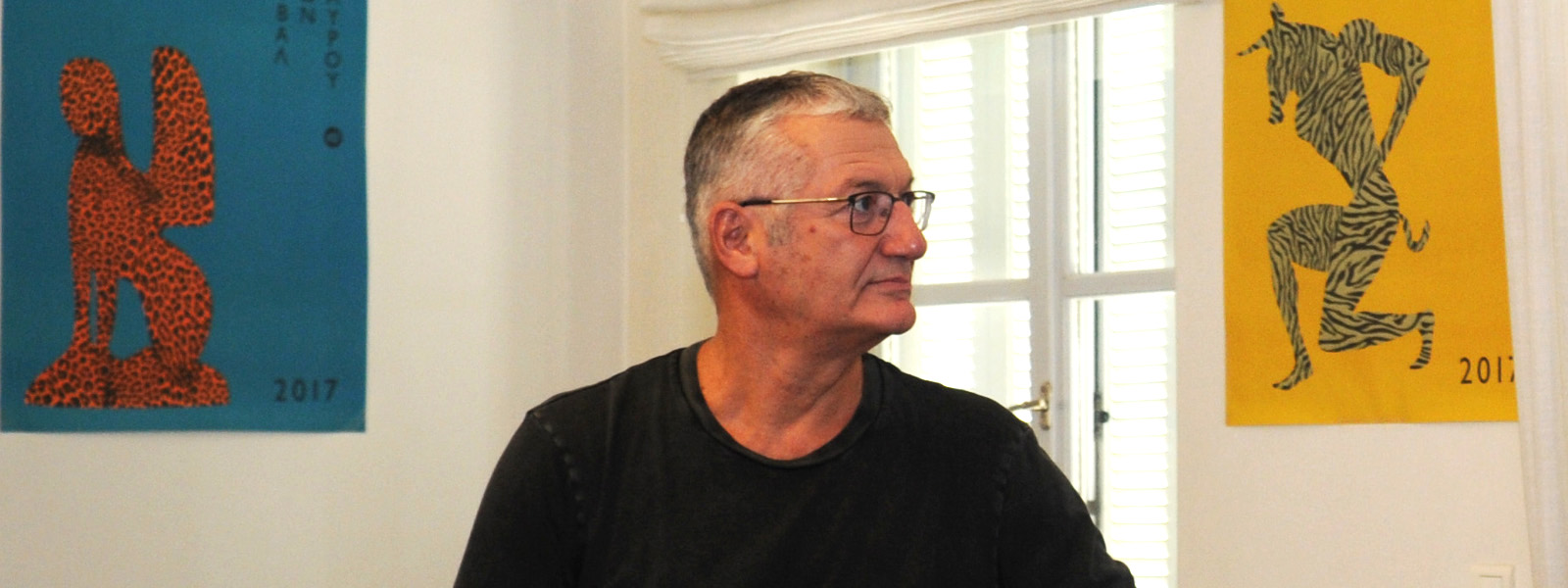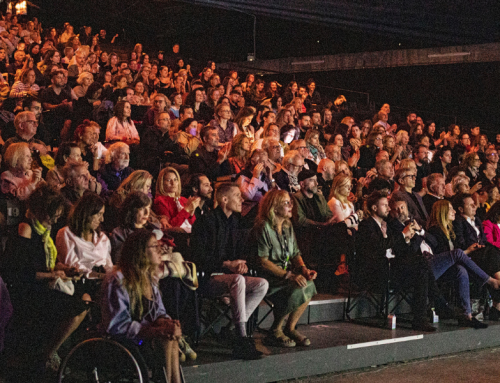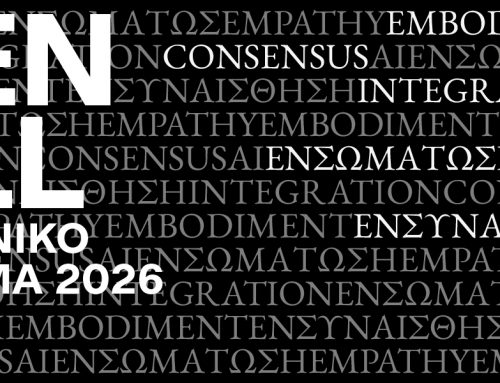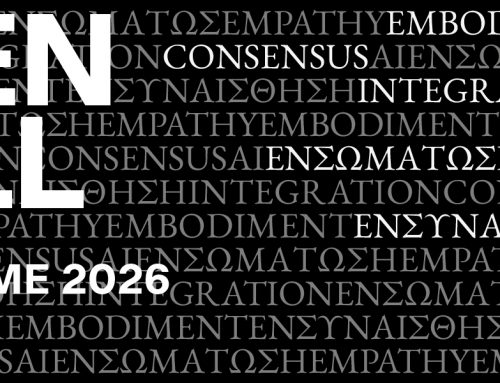Artistic director Vangelis Theodoropoulos elaborated on the triumphs and pitfalls of the 2017 Athens & Epidaurus Festival in a press conference held on 4 October 2017. A transcription of the speech follows.
I became artistic director of the Athens & Epidaurus Festival about a year and a half ago. The 2017 edition of the Festival was essentially the first to bear my – our – brand and flavour, to the best of our ability. It goes without saying that there is a learning curve to master this job. We learned a great deal of things, my team and I, and are now ready to tap into this valuable insight for our next edition of the Festival.
With that in mind, we invited you here to look back at the 2017 Athens & Epidaurus Festival – a retrospective analysis which I deem necessary for all public institutions.
First of all, I’d like to thank the Festival’s board of directors, my close collaborators and all Festival employees who worked hard to make this happen, the artists, Greeks and foreigners alike, the Hellenic Ministry of Culture, the public and private institutions, the sponsors, the audience who embraced our events and performances, and even you, the journalists, who contributed to our endeavour through your tough critiques.
EPIDAURUS LYCEUM
I will begin with what I consider as something fresh, but also crucial for our culture, and one of the main reasons I am active in this Festival: the foundation of the Epidaurus Lyceum and its connection with the Ancient Theatre of Epidaurus and the Little Theatre of Ancient Epidaurus, its educational and international character, its ties to the local community. The Lyceum was an idea and a vision which has preoccupied many worthy individuals before yours truly, ever since the Epidaurus Festival was first held; a dream that has finally come true. I am proud of the Lyceum, first and foremost because it was launched during my tenure. Many people found it difficult to believe that the Lyceum could be launched within a year after its creation was announced. We put together a formidable team, with Georgina Kakoudaki on charge. We invited major teachers of the performing arts, Greeks and foreigners alike, ranging from Phillip Zarrilli and the main collaborators of Arianne Mnouchkine, Simon Abkharian and Catherina Schaub, to Enrico Bonavera – a great drama teacher and Strehler’s final Master of Two Servants –, Rosalba Torres Guerrero – a core member of Anne Teresa de Keersmaeker’s Rosas group –, choreographer Koen Augustijnen – a close collaborator of Les Ballets C de la B –, RootlessRoot, the ensemble who trained the students every morning at the ancient stadium of Asklepion, Martha Frintzila, Simos Kakalas, Rinio Kyriazi, Konstantinos Ntellas, Miranda Terzopoulou, and numerous others.
The Lyceum has finally come true: a place where drama teachers, actors, dramaturgs, directors, musicians, choreographers, theatre researchers, anthropologists and musicologists can exchange ideas and new trends on dramatic practices and research. At the same time, a place where tradition can exist side by side with innovation; a place where the ancient and the contemporary Greek culture can coexist in peace.
The Lyceum’s programme of studies fell under the overarching theme “The Arrival of the Outsider” and included classes held in outdoor spaces, such as the Ancient Stadium of Epidaurus and the courtyards of Byzantine churches, as well as educational and cultural sites of the Lygourio village.
Furthermore, the programme included a number of theory workshops and lectures, most of them open to the public, in an attempt to strengthen the ties of the Lyceum to the local community.
The Lyceum’s student body and teaching staff participated in cultural excursions in Nafplio, Argos, and Mycenae and attended performances and rehearsals at the two Epidaurus theatres.
The Epidaurus Lyceum was active between July 4 and 19, and was attended by 120 students of drama schools and theatre departments, as well as young actors from around the world (Iran, France, USA, Australia, Germany, Lithuania, Lebanon, UK, Mexico, Brazil).
The Epidaurus Lyceum was realized thanks to the support of the Hellenic Ministry of Culture and the Municipality of Epidaurus and is a member of the International Network of Ancient Drama.
The Lyceum’s theme for 2018 is “Polis and the Citizen.” Courses will be held in two periods, 2-16 July and 18 July-1 August.
EPIDAURUS
Regarding the performances at the Ancient Theatre of Epidaurus, the overall sense is one of success. We achieved major co-productions with the Municipal and Regional Theatres of Ioannina and Larissa. We are particularly proud of the successful run of The Persians, a Cyprus Theatre Organisation production directed by a young Greek director, Aris Biniaris, on commission by the Festival. Thanks to such commissions, especially to younger and promising creators, the role of the Festival as a producer of culture comes fully alive. Allow me to also mention Alcestis, directed by the – also young – Katerina Evangelatos, on commission by the National Theatre of Greece; a standout performance, applauded by audience and critics alike. Our re-run of Seven Against Thebes by the National Theatre of Northern Greece also met (again) with success.
As far as the Little Theatre is concerned, we are satisfied by the new purpose and quality with which we have infused the venue. We promoted a more alternative take on ancient drama. Younger teams and directors were commissioned, a project which proved to be fruitful and, in fact, complementary to the Ancient Theatre programme, bearing in mind that the audience and the artists are always thrilled to come in contact with these archetypal texts. The rationale behind our effort was solid enough and the performances presented at the Little Theatre were of high quality; therefore, our gamble paid off, a fact that was evident in the feedback we got from the audience and the mostly enthusiastic reviews.
Let me also mention here the Festival d’Avignon production Prometheus Bound – The Suppliants, directed by Olivier Py.
I should also clarify that all Epidaurus performances, without exception, came with English subtitles, a policy which we intend to continue next year.
OTHER ACTIVITIES IN EPIDAURUS AND ARGOLIS
Epidaurus Creative Workshop for Children: Held at the Xenia Epidaurus (Costume Museum). Children attended a workshop, run by six theatre educators. The workshop reflected the themes of the plays presented contemporaneously at the Epidaurus theatres. Children’s parents and legal guardians attended the Epidaurus performances, while their children and wards were kept busy with creative activities.
Educating audiences in ancient drama: Held between March and June 2017, in collaboration with the Department of Theatre Studies of the University of the Peloponnese. Sixteen theatre educators ran this workshop in schools and other venues in the Epidaurus area. The workshops aimed to familiarize audiences of all age groups with the plays that were to be presented later in the summer at the Epidaurus theatres. The programme successfully ran its course and was completed on 10 June, at the theatre of Akronafplia, with the attendance of over 300 people.
OPENING TO THE CITY
This year we also introduced the section known as Opening to the City. Through diverse, large- or small-scale events and activities, we brought together citizens of various age groups, classes, educational backgrounds, families, children, the elderly, parts of the population who may have never been at the Peiraios 260 or at the Odeon of Herodes Atticus, and gave them the opportunity to watch high-quality performances. Performances who took us along for a ride to unique, less visible parts of Athens. Some of these performances were site-specific. We also watched experimental performances and promenades in historic sites of Athens. We are keen on keeping and boosting this section for our bext year’s programme. Next year, we will focus exclusively on site-specific performances – this organic connection with specific sites drew large crowds. I should add that all Opening performances held in outdoor public spaces were free of charge and took place in Athens, Piraeus, and one of them in Eleusis.
A few people keep asking me: “Why should the Festival expand all over the city, all the way to Piraeus, in the first place? In the summer, many events are already being held in various neighbourhoods of Athens, anyway.” To them I say: we don’t really see commissioned performances, conceptual performances about Athens and its port city, performances that meet the Festival’s strict artistic criteria: boldness, originality, keeping in touch with contemporary aesthetic trends. A few of these performances, which were warmly received by the audience, will be repeated next year: Thodoris Gonis’ National Garden and Konstantinos Mihos’ Iphigenia at the Perama Ship Repair Zone.
I can’t help but mention More Sweetly Play the Dance, a large-scale video installation by the great William Kentridge. For 40 nights in a row, the installation was projected at the Dionysiou Areopagitou pedestrian street, where thousands of Greeks and foreigners had the opportunity to watch it; truly, a major artistic event.
This year’s programme was criticized for being too expansive. The truth of the matter is that, yes, our Opening section added 32 productions to the final tally. Until recently, the total number of performances held at the Epidaurus theatres, the Odeon, and Peiraios 260 were, on an average, about 80. This year, due to the Opening, we presented 114 productions. Quantity often overshadows quality and I guess this is what happened with us. But not because the quality of our programme was lower than expected; quite the opposite, in fact. Offering too many good performances means that you make it more difficult for the audience to pick and choose among them. It is also more difficult to effectively promote so many performances. We will trim down our 2018 programme, in the hopes of more effectively highlighting and promoting our artistic choices.
Naturally, not every type of performance can appeal to all audiences. The average theatre-goer does not share the logic of theatre professionals who may be interested in watching as many and diverse productions as possible. We need to respond to as wide an audience as possible, offering a diverse range of productions and hoping for the best artistic result possible. We are also keen to schedule performances of great potential to be presented more than twice, as was the standard practice until now.
PEIRAIOS 260
CONTEMPORARY GREEK THEATRE
There is always a greater risk involved in contemporary Greek theatre, because these performances are usually selected on the strength of artists’ proposals rather than an already prepared production (as is usually the case with international productions). However, we should not be daunted by this risk, this confrontation with the dynamics of contemporary theatre. The Festival needs to be both the recipient and the active producer of culture. Audiences are cultivated when exposed to successful international productions, but also when keeping in touch with ‘home’ productions.
This year’s contemporary Greek theatre programme (mainly held at Peiraios 260) boasted 15 productions, most of them by rising Greek directors. We had a strong opening, with a re-run of The Massacre at Paris by the young but exquisitely well put together Orchestra of Little Things. This year’s programme placed an emphasis on contemporary culture: Nikita Milivojevic’s The Bridge on the Drina; Nova Melancholia and Vassilis Noulas’ Maritime Hot Baths; Enke Fezollari’s Sworn Virgin. We also had our share of ‘proper’ theatrical plays, including Georgia Mavraganis’ Suddenly, Last Summer, praised by audience and critics, Simos Kakala’s variety show, and the subtle Moonstruck, a play in verse by the Cypriot folk poet Pavlos Liasides, directed by Nikos Chatzopoulos. Dimitris Kourtakis’ extremely ambitious and masterly Failing to Levitate in my Studio was the perfect ending to our 2017 Greek programme. Inspired by Beckett’s universe, this performance wove together poetry, video and performance, and met with extraordinary success; as such, it will be repeated in 2018.
INTERNATIONAL PRODUCTIONS
Our international programme for 2017 was much richer than the one we had last year. Not only did we host more international productions, but these productions were of much greater scale and range.
Our first international production, the politically charged Hymn to Love by young Polish director Marta Gurnicka kicked off a year full of powerful voices. In the first nine days of the Festival, the British Forced Entertainment company presented Shakespeare’s complete works at the new B space at Peiraios 260. The ten-day tribute to the famous Volksbuhne and its outgoing artistic director, Frank Castorf, was one of the most important and unique moments of the 2017 international programme. The Berlin theatre came to Athens for three great performances directed by Castorf, Rene Pollesch and Herbert Fritsch. The courtyard of Peiraios was transformed through festivities, movie projections, concerts, smaller performances and a huge installation. The audience had the chance to become familiarized with Volksbuhne and the tremendous influence it has exerted to the European theatre over the past twenty years. A not-to-be-missed occasion, since this specific artistic team has now left the Volksbuhne.
Our programme boasted international stars, household names such as Robert Wilson and Romeo Castellucci, as well as younger creators. Two of the artists we presented last year came back in 2017: Milo Rau, with the third installment of his Europe Trilogy, and young French director Julien Gosselin, who gave us a riveting adaptation of Michel Houellebecq’s novel Atomised.
Many of the theatre and dance performances were presented at the Athens Festival shortly after their international premiere. Several of them were co-productions or adaptations for our programme, including Hofesh Shechter’s sold-out performance and one of the most intriguing artists of the contemporary European dance world, Marlene Monteiro Freitas from Portugal with her Bacchae.
For the first time ever, the Festival included projects by internationally acclaimed visual artists. Julian Rosefeldt’s video installation Manifesto, starring Cate Blanchett, was projected on 13 screens, transforming the acoustics of Peiraios A and generating a one-of-a-kind visual space.
DANCE
Thirteen artistic groups participated in the main dance programme (7 Greek and 6 international groups) and 4 groups presented their work at the Opening section, 3 of whom performed in Piraeus. Furthermore, 3 dance workshops, a book launch with free distribution and 3 discussions with artists, open to the public, were also held.
An increase in the number of dance productions is evident. Some observations can also be made with regards to the production’s qualities:
1. The Opening to the City section attempted to open dance up to a new audience. Artists experimented with new forms, hybrid conditions and artistic questions which, inevitably, took the social context into account, since these works were conceived with the public space in mind. Moreover, these productions met artists’ needs and concerns, which the Festival should not ignore if it wishes to remain a living, evolving entity.
2. The educational activities met with great success, drawing participants of high quality and offering a great experience to participants. A special mention is due to the Post Dance book launch which provided a bridge with dance theory scholarship. Last but not least, the post-performance talks aimed to expand and cultivate our audience, in the sense of “I understand more, therefore I enjoy the performance more.”
Many dance performances successfully introduced the best artists and productions currently presented at the topmost festivals of the world to the Greek audience, some of them shortly after their international premiere. There was even an attempt to bring the audience and the artist together in a different, non-traditional way, through the “one-to-one” format, that is, the presentation of a work to one or two spectators, the format being integral to the work’s structure.
Finally, it is important to acknowledge co-productions with international institutions and an attempt to support Greek artists and to promote their work to Europe and worldwide. With that in mind, two Greek artists joined the DNA European dance network, while four Festival productions and co-productions are being presented to international festivals and theatres: Euripides Laskaridis’ Titans, Ioanna Portolou’s Porn, RootlessRoot’s When the Dogs Assailed their Masters and Katerina Andreou’s A Kind of Fierce.
EDUCATIONAL WORKSHOPS IN ATHENS
A total of 10 educational activities were held in Athens, with the participation of about 550 artists and students. Furthermore, 7 post-performance talks involving international artists were held. These events met with success: applications for attendance vastly exceeded the initially announced number of participants.
A FEW WORDS ABOUT MUSIC
My tenure is still quite “young”; by contrast, the Festival itself has a long and rich history. It is difficult to breathe new life into all Festival sections at the same time. To explain myself: we just didn’t have the time to organize the music programme in the best possible way. By that, I don’t mean, of course, that the Festival lacked major musical events. Hopefully, in 2018, we will have a tighter approach to the music programme, with a focus on the Odeon of Herodes Atticus.
This brings me to a happy announcement: Kostas Pilavakis will join our team of curators. With his long and distinguished career and his leading positions in some of the biggest recording companies in the world (Deutsche Grammophon, Decca, Philips Classics), Mr. Pilavakis will be our co-curator for music.
In 2017, we achieved many things. We emphasized co-productions, a standard practice in international festivals. We enjoyed dynamic co-productions with the Municipal and Regional Theatres, with independent Greek and foreign institutions and international festivals, to the economic benefit of everyone involved. As a result, performances can be repeated all over Greece and abroad. This is, after all, the goal of a work of art: to be enjoyed by as wide an audience as possible.
Regarding the promotion of Greek productions in festivals abroad, the Athens & Epidaurus Festival, together with the Hellenic Ministry of Culture, invited 18 artistic directors and representatives of various international festivals to come to Athens and Epidaurus for four days and watch Greek theatrical and dance performances, some of which are currently touring worldwide.
In addition, we have started going through the Festival archive and organizing it. Another difficult task which we have begun to undertake is to organize and tidy up the Festival wardrobe.
I am saving a few economic data for the end. Although the programme was much bigger this year (in sheer number of productions), the initial budget was significantly cut. Thanks to donations, co-productions, memorabilia sales in addition to tickets, our revenue was about 2 million euros, meaning that this year we are having a small surplus.
Moreover, this year, for the first time since last year, producers are being paid only after all the necessary documents have been submitted. It is important to us that all artists are paid on time.
This year saw a rise both in audience numbers and ticket revenue. I am going to read you the official box-office data for 2017:
Total audience number 203,211
Ticket sales 167,392
Total revenue 3.602.534,30 euros
I have not included a) the thousands of spectators who watched the Opening performances free of charge, b) the economic data from Festival productions and co-productions presented in Greece and broad; this data has not yet been collected.
In conclusion, I would like to thank the sponsors and institutions that supported us in many ways:
The Department of Theatre Studies of the University of the Peloponnese, the Municipality of Epidaurus, the Administration of the Peloponnese, the Regional Administration of Argolis, the Ephorate of Antiquities of Argolida (Argolis), the Municipality of Nafplio, the Elliniki Etairia – Society for the Environment and Cultural Heritage, the Hellenic Ministry of Labour, the City of Athens and the Athens Culture Net, the National Bank of Greece, the Hellenic Broadcasting Corporation (ERT) and the Third Programme (Trito Programma) radio station, the Piraeus Municipal Theatre, the Institut Français, the Goethe-Institut, the Onassis Cultural Centre, the 1st Ephorate of Ancient and Classical Antiquities, the Eleusis 2021 European Capital of Culture, the Athens International Film Festival, the Michael Cacoyannis Foundation, the City of Athens Cultural, Sport & Youth Organization (OPANDA) and the National Garden, the DNA Dance Network, the Embassy of Greece in Tehran, our media sponsors and other sponsors: ΤΕRΝΑ ENERGY, Aegean Airlines, Pireaus Bank, the Public Power Corporation (DEI), the Athens International Airport, Coca Cola.
I would also like to thank the Institute of Public Health, for kindly providing us with the space for today’s press conference.









